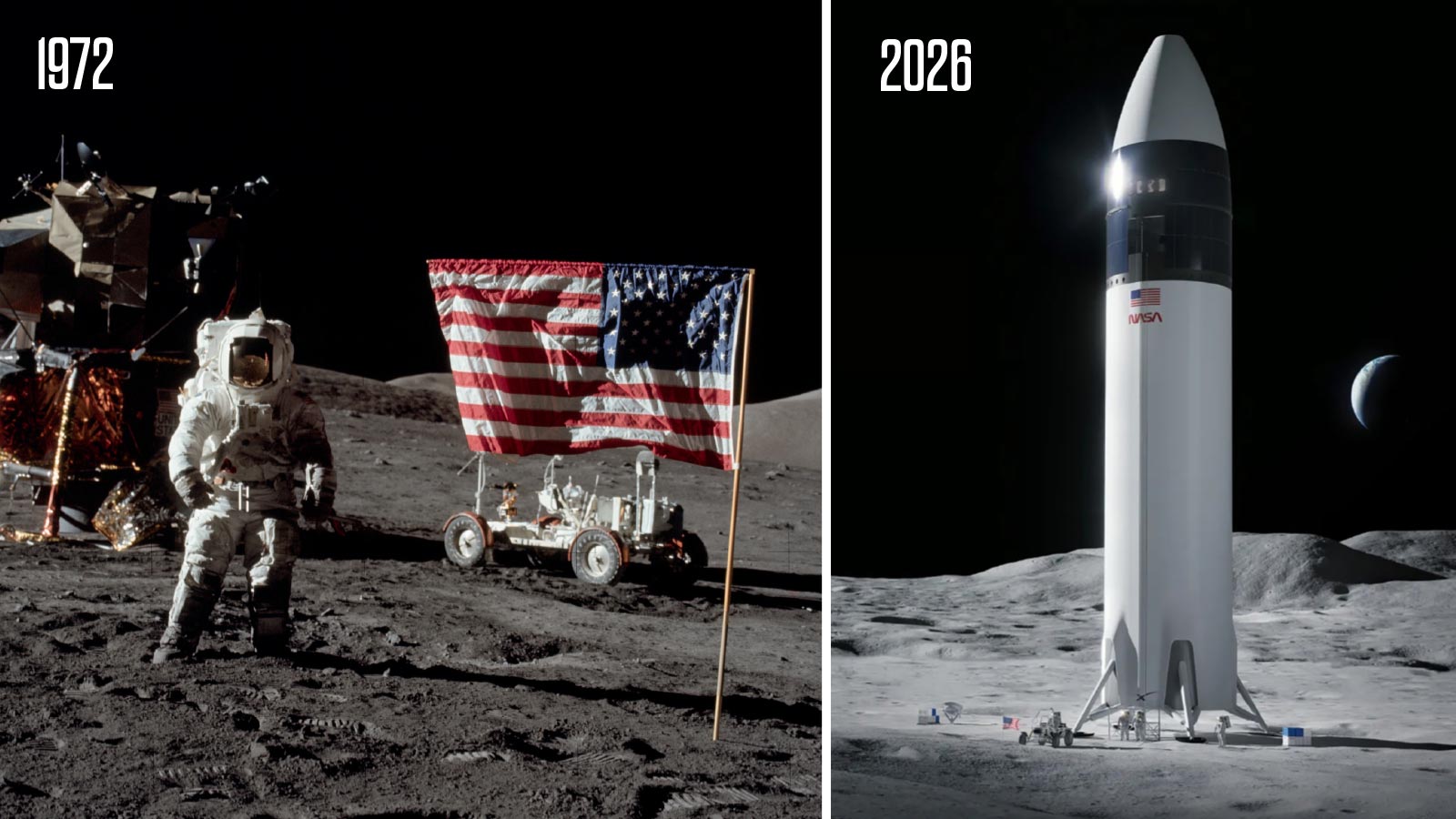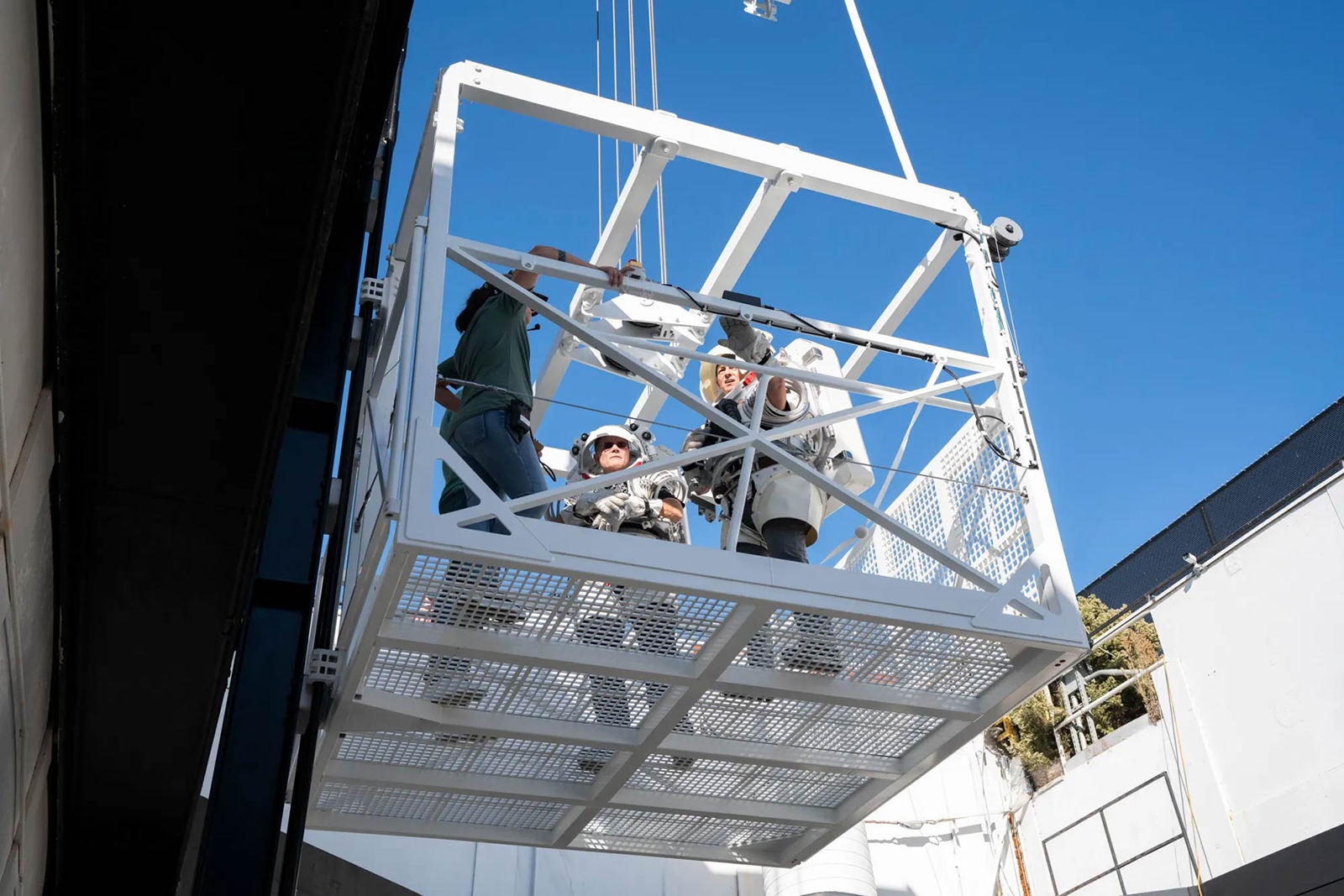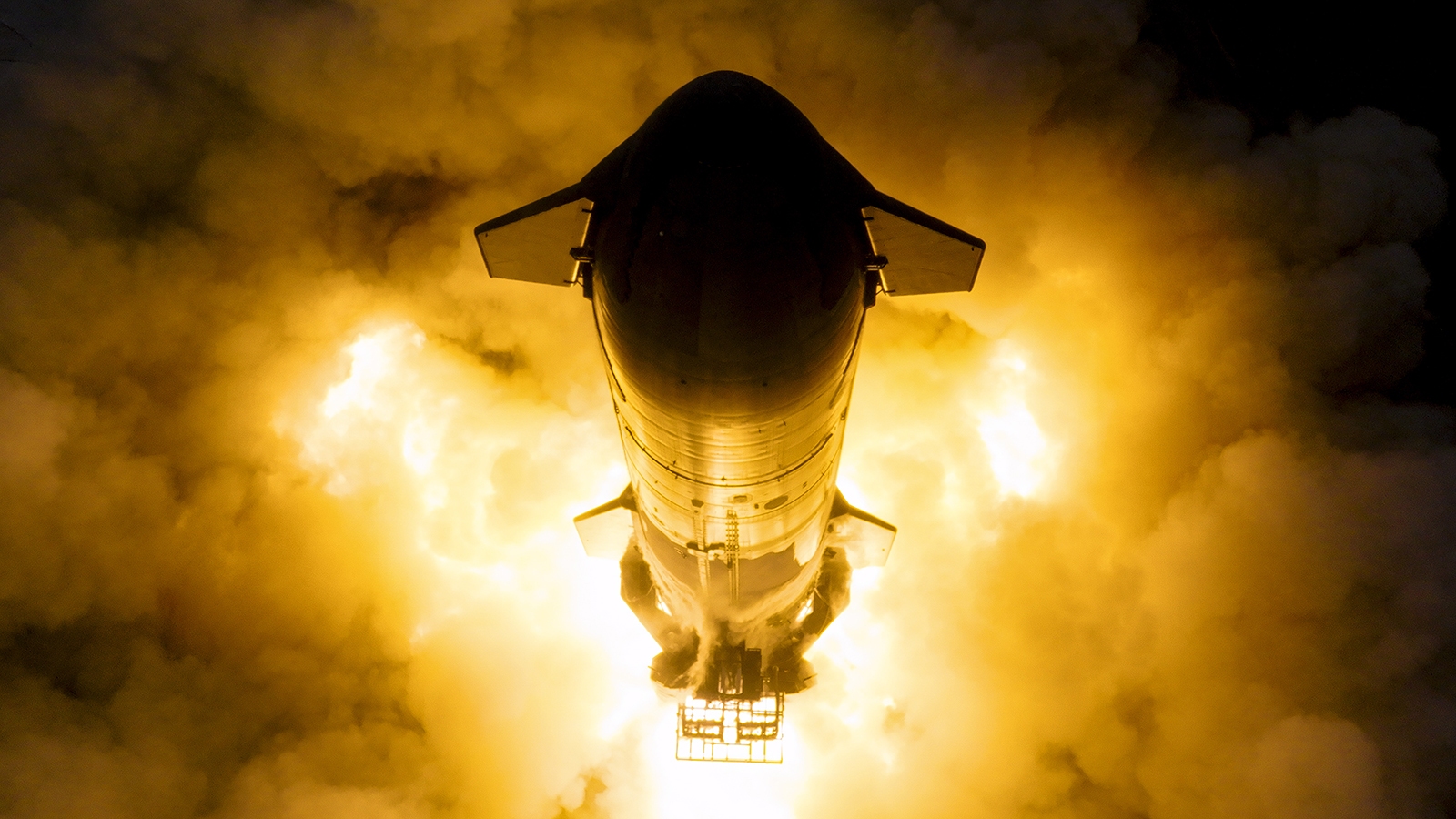Stay Up to Date
Submit your email address to receive the latest industry and Aerospace America news.
NASA plans to return humans to the moon in 2026. How real is that date? Jonathan O’Callaghan looks at the long to-do list.
By NASA’s latest schedule, we are a little more than two years away from witnessing a historic moment: the return of humans to the moon.
Here’s a snapshot of what must happen between now and then: SpaceX must boost a Starship spacecraft to Earth orbit atop a Super Heavy booster to prove that it can do the same with the $2.9 billion lunar lander version of Starship. In the 2026 mission, this Starship Human Landing System will have exhausted its propellant after separating from the Super Heavy, so SpaceX must show that it can be refueled in Earth orbit to continue on to lunar orbit and then down to the surface and back up. Ahead of time, multiple Starships must be launched to accumulate propellant in a depot that does not yet exist but which Elon Musk has described as a massive version of Starship. Turning to the crew members, they will have been boosted to lunar orbit separately, in an Orion capsule atop a NASA Space Launch System rocket. Once out there, they must dock with the refueled Starship for the landing. But before NASA entrusts the Starship with their lives, SpaceX must land an unoccupied one on the moon and lift off again. NASA, it could be argued, has it a little easier. Ahead of 2026, it must send a crew looping around the moon in the Artemis II mission, a human version of the unoccupied Artemis I demonstration of 2022.
Given all that, the feasibility of the September 2026 target for Artemis III remains an open question, just as was the case for the previous target dates of 2024 and 2025. NASA has, at times, indicated flexibility about which Artemis mission will mark the return to the moon. At the moment, even the spacesuits for the landing are still in development by Axiom Space in Houston [see “Tomorrow’s spacesuits”].
“I do believe that progress is being made, and we are certainly closer now than we ever have been,” says space consultant Laura Forczyk of Georgia-based Astralytical. “But there is a lot of work to do.”
This account is based on interviews with current and former NASA officials, former SpaceX employees and a review of public remarks, government documents and press releases. Multiple requests were made to SpaceX by phone and email for comment, but the company did not respond.
The delays thus far have stemmed from the mission’s ample and interrelated hardware. In Apollo 11, getting three astronauts to space and two of them to the surface required sending up everyone and everything on one rocket, a Saturn V. In Artemis III, getting four astronauts to space and two to the surface will involve more than twice the amount of hardware. Still more hardware will come later when the elements of NASA’s Gateway space station are launched and assembled in lunar orbit. Once Gateway is ready, each Orion will dock there instead of with a Starship or Blue Origin’s planned Blue Moon lander.

The plan is “complex,” says Abhi Tripathi, an aerospace engineer at the Space Science Laboratory at the University of California, Berkeley and a former mission director at SpaceX. “You have the SLS launch, you have an Orion, you have Starship going up and down. The inevitable question must be asked at some point: Is there a way to simplify the architecture?”
NASA has shown no inclination to do so. The agency has been adamant that this collection of vehicles plus Gateway will establish a sustainable era of lunar exploration and avoid anything like the 54-year gap between the Apollo 17 mission in 1972 and Artemis III.
The program’s history, and quotes from managers, suggest that they would rather slip the schedule than overhaul the architecture.
As it pushes “boundaries that have not been pushed before,” NASA is “constantly evaluating” its schedule, and indeed has “a lot to do,” Jacob Bleacher, NASA’s chief exploration scientist, said at a town hall meeting at the Lunar and Planetary Science Conference in Texas in March, according to a video of the event.
In March, SpaceX proved that it can get a Starship to space, although the vehicle disintegrated on reentry. The next milestone will be getting a Starship to space and back to prove its reusability. That will be followed at some point by a demonstration of propellant transfer between two Starships as a step toward the depot.
“I would like to see a detailed plan of how we’re going to get the technology developed and demonstrated at scale for the propellant depot,” says Dan Dumbacher, CEO of AIAA (publisher of Aerospace America) and formerly a deputy associate administrator at NASA Headquarters in Washington, D.C.
The propellant would need to be kept cold to avoid or limit boil off over time. “It’s going to warm up, and you’re going to lose some of the quality,” says Dumbacher. “You have to account for that in your refueling cadence.”
SpaceX has not elaborated on the logistics of transferring and storing the fuel. “Is their plan to have a propellant depot in orbit for five years or whatever?” says Tripathi. “They need to eventually talk more about that. There’s nothing in the public domain that I’ve seen.”
There also have been shifting accounts of how many Starship launches will be required to fill the depot. Musk said in a post on the former Twitter in August 2021 that as few as four launches could suffice. But in November, Lakiesha Hawkins of NASA’s Moon to Mars Program Office said the number of required launches could run “in the high teens.” Her briefing to members of a NASA Advisory Council committee comported with NASA Associate Administrator Jim Free’s April statement during an interview with Aerospace America that 12 to 15 launches would be needed.
Lisa Watson-Morgan, NASA’s Human Landing System program manager in Alabama, tells me in an interview that she expects SpaceX to begin orbital testing next year to ascertain how big an issue propellant boil off or other factors will be. “Once we prove that out, I think we’ll have a more solid number of flights.”
As for how the astronauts will get from Orion onto Starship, Watson-Morgan says work on a docking apparatus, while “not highly publicized,” is already underway.
“We had a docking adapter test earlier this year at [the Johnson Space Center in Texas] with the Starship docking system,” she says.

Turning to the all-important landing, the concerns are multiple. Starship will come down base first, with an unspecified number of its six engines slowing it. Musk in the past has said that additional thrusters located higher up the vehicle might be installed for the landing maneuver.
“You can imagine it kicking up a lot of rocks,” says Tripathi, “which is debris that can impact your spacecraft.” That’s one reason NASA’s HLS contract with SpaceX requires the uncrewed demo landing.
After touchdown, there will also be the matter of getting the astronauts down to the surface from the crew area, which Tripathi estimates will be located about 30 meters up the 50-meter-tall lander, based on his review of NASA documents and the SpaceX illustrations. Plans call for the two astronauts to ride an exterior elevator to the surface, and testing is already underway. A SpaceX photo shared by NASA in December shows two spacesuited astronauts standing in an open-frame, basketlike elevator outside a building at SpaceX’s headquarters in Hawthorne, California. In response to emailed questions, NASA said that once Starship lands, the astronauts must open the payload door to deploy the elevator outside the lander, then climb in for their ride down to the surface.
If you think this sounds potentially precarious, you are not alone.
Starship’s height is a potential concern “from the standpoint of: The closer I have the astronauts to the surface, the easier the job is,” says Dumbacher. “SpaceX has made the calculation the risk is worth the reward. We’re doing this kind of thing for the first time in a one-sixth gravity environment. We’ll be able to figure it out over time, but the first couple of times, Mother Nature has a wonderful way of keeping us all humble.”
Dumbacher compares the situation to the questions over the thermal protection tiles that shielded the Columbia orbiter during its return to Earth in the shuttle design’s 1981 debut. “When we brought shuttle home, it was the first time we tested those tiles,” he says. “We don’t want to do something like STS-1 where we put the astronaut lives at risk. We had a lot of open risk items on the shuttle program.”
Tripathi adds: “I don’t think there’s anything in theory wrong with the elevator,” which is “a perfectly good idea. But when you plan space missions you tend to want to reduce complexity. With an elevator system, you do have to worry about something breaking.”
Watson-Morgan says that, in order for NASA to certify Starship as safe to transport humans, it might require some sort of backup.
“There is a secondary mechanism that we are working with SpaceX on to make sure that we do have the ability to get the crew back should the elevator fail,” she says. NASA did not respond to follow-up questions asking for further detail.
Then there is the stability of Starship at landing to consider. Apollo 11’s Eagle lander was short and squat compared to Starship. Specifically, Eagle was about 9 meters across, just like Starship, but Starship will be 50 meters tall compared to Eagle’s 7 meters.
“As a blanket statement I believe all lunar landers, and certainly the two human lunar landers under contract” — meaning Starship and Blue Origin’s Blue Moon — “have a very high bar to prove to NASA that they can land safely and not tip over,” says Tripathi by email. Of special concern are “the leg deisgn and center of mass,” he adds.
All told, “there is nothing inherent in the illustrations we see of Starship that would make me more concerned about it, than any other lander design, including ones much smaller or uncrewed,” he concludes.

Like so much in the Artemis program, there is a lack of certainty about the landing and the technology that the astronauts will depend on. At the moment, even those who should be the greatest advocates of Artemis are left hungering to know more about the landing, about the propellant depot concept, about the docking technology for a mission that in theory could be just 27 months away.
“I wish there was more communication between SpaceX, NASA and the general public,” Forczyk, the analyst, says.
About Jonathan O'Callaghan
Jonathan is a London-based space and science journalist covering commercial spaceflight, space exploration and astrophysics. A regular contributor to Scientific American and New Scientist, his work has also appeared in Forbes, The New York Times and Wired.
Related Posts
Stay Up to Date
Submit your email address to receive the latest industry and Aerospace America news.




